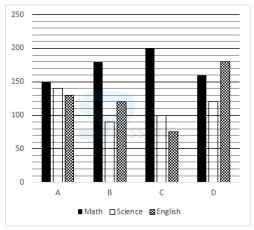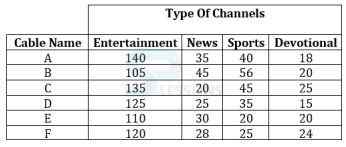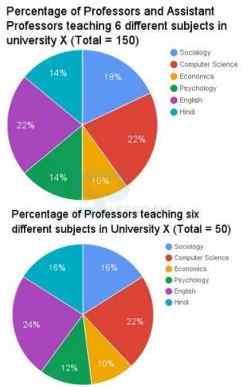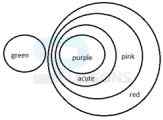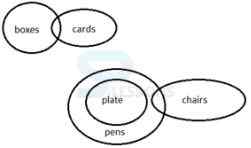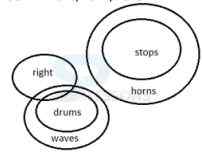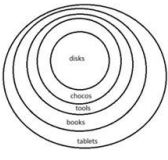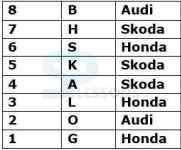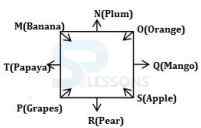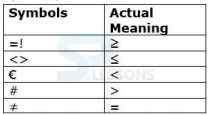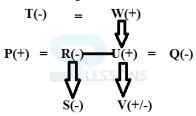 Introduction
Introduction
IDBI Bank Assistant Manager 2019 notification out. IDBI Bank has released the Assistant Manager recruitment notification for a total of 600 vacancies. IDBI Bank Assistant Manager apply online link activated at the Official Website.
The Online Application for IDBI Bank notification started on 23rd June 2019. The last date to pay the fee and submitting the application form is 3rd July 2019. IDBI also has announced IDBI Bank Assistant Manager exam date 2019 for the written exam at the Official Website. As per the notification, the IDBI Assistant Manager exam will be conducted on 21st July 2019.
The article IDBI Assistant Manager Model Test provides guidelines to the candidates about framing of questions in IDBI Bank 2019.
 Pattern
Pattern
The IDBI Assistant Manager 2019 Stage – 1 Online Test consists of four different sections containing different marks with a total of 200 marks .
| Sr. No | Name of Tests | No. of Qs. | Max. Marks | Version | Time allotted for test |
|---|---|---|---|---|---|
| 1. | Logical Reasoning, Data Analysis and Interpretation | 60 | 60 | Only English | Composite time of 2 hours |
| 2. | General/ Economy/ Banking Awareness | 60 | 60 | ||
| 3. | English Language | 40 | 40 | ||
| 4. | Quantitative Aptitude | 40 | 40 | ||
| Total | 200 | 200 | |||
 Test
Test
Direction (1-10): Read the following passage carefully and answer the questions that follow. Certain words are printed in bold to help you locate them while answering some of these. Without, the night was cold and wet, but in the small parlour of Laburnam Villa the blinds were drawn and the fire burned brightly. Father and son were at chess, the former, who possessed ideas about the game involving radical changes, putting his king into such sharp and unnecessary perils that it even provoked comment from the white haired old lady knitting placidly by the fire. “Hark at the wind,” said Mr. White, who, having seen a fatal mistake after it was too late, was amiably desirous of preventing his son from seeing it. “I’m listening,” said the latter, grimly surveying the board as he stretched out his hand. “Check.” “I should hardly think that he’d come to-night,” said his father, with his hand poised over the board. “Mate,” replied the son. “That’s the worst of living so far out,” bawled Mr. White, with sudden and un looked-for violence; “of all the beastly, slushy, out-of-the-way places to live in, this is the worst. Pathway’s a bog, and the road’s a torrent. I don’t know what people are thinking about. I suppose because only two houses in the road are let, they think it doesn’t matter.” “Never mind, dear,” said his wife, soothingly; “perhaps you’ll win the next one”. Mr. White looked up sharply, just in time to intercept a knowing glance between mother and son. The words died away on his lips, and he hid a guilty grin in his thin grey beard. “There he is,” said Herbert White, as the gate banged to loud and heavy footsteps that came toward the door. “Sergeant–Major Morris,” he said, introducing him. “I’d like to go to India myself,” said the old man, “just to look round a bit, you know.” “Better where you are,” said the sergeant-major, shaking his head. He put down the empty glass, and sighing softly, shook it again. “I should like to see those old temples and fakirs and jugglers,” said the old man. “What was that you started telling me the other day about a monkey’s paw or something, Morris?” At Mr. and Mrs. Whites’ urging, Sergeant-Major Morris takes a small, mummified paw out of his pocket. He explains that a fakir (a mystic miracle worker) placed a spell on the paw to prove that people’s lives are governed by fate and that it is dangerous to meddle with fate. According to the sergeant-major, three men can wish on the paw three times each. The sergeant-major himself has already had his three wishes, as has another man, who used his third wish to ask for death. The sergeant major has considered selling the paw, but he doesn’t want it to cause any more trouble than it already has. Moreover, no one will buy the paw without first seeing proof of its effect. The sergeant-major throws the paw into the fire, and Mr. White quickly rescues it. The sergeant-major warns him three times to leave the paw alone, but he eventually explains how to make a wish on the paw. “Sounds like the Arabian Nights,” said Mrs. White, as she rose and began to set the supper. “Don’t you think you might wish for four pairs of hands for me? ”Her husband drew the talisman from pocket, and then all three burst into laughter as the sergeant major, with a look of alarm on his face, caught him by the arm. “If you must wish,” he said, gruffly, “wish for something sensible.”
1. Which of the following can be inferred about the playing tendency of the man and the son?
-
A. The father was not very good at playing chess and was losing continuously.
B. The father was intentionally losing to his son for cheering him up.
C. The father was not hesitant to take hasty steps and was playing restlessly.
D. The son was too engrossed in the game but the man was playing just to appease his son.
E. The game was being played between two experts and the game was getting more difficult with each round.
-
A. The Whites were waiting for a visitor who was not intent on coming.
B. The Whites were waiting for someone but their residence was in an isolated locality.
C. The Whites were enjoying themselves and did not want any intruder.
D. The father was not welcoming and was nervous about the visitor’s visit.
E. The father wanted the family to welcome the visitor with all their warmth.
-
A. Mrs. White did not leave a single chance to demean her husband.
B. Mrs. White liked it when her husband lost any game to his son.
C. Mrs. White liked to tease her husband and was pulling his leg.
D. Mr. White was complaining because he had lost the game.
E. Mrs. White wanted her husband to stop grumbling as they had no choice but stay there.
-
A. He did not hold very high opinions about the paw and considered it to be a danger.
B. He was mesmerized by the power of the paw and was repentant that he had not used its powers correctly.
C. He wanted to wish using the paw again and was upset that his three wishes had been wasted.
D. He did not believe in the paw’s power and was embarrassed that he would be laughed at.
E. He was jealous that the Whites might get something good using the paw.
-
A. Morris wanted to make the situation a bit light and made everyone laugh.
B. Morris was extremely superstitious and believed in magic and all supernatural things.
C. Morris wanted to scare his friend’s family and get fun out of it.
D. Morris tried to make the situation more intense and reacted more.
E. Morris was scared as he knew the paw could make anything come true.
-
A. The Whites were confused and pretty scared after the story of the paw was narrated to them.
B. The Whites did not believe the story and took the paw quite lightly.
C. The Whites were excited and wanted to make extravagant wishes.
D. The Whites felt their friend was trying to scare them and make up stories so they would not give in.
E. The Whites were mocking at Morris and wanted to have a good laugh at the story of the paw.
- A. Boldness can at times save a person from danger but not always.
B. Magic and all supernatural forces are existent in today’s life and people must not ignore it.
C. It is not good to interfere in fate’s decisions as it only brings trouble.
D. Human beings are so foolish that they cannot even bring their own good.
E. Magic always comes with a price so it is better to stay away from it.
- A. Hazards of aspirations
B. Deception by one’s own friends
C. Imagination by people
D. Supernatural forces harming people
E. Darkness of the night enlivens a number of supernatural forces
- A. Wonderfully
B. Unskilled
C. Excitedly
D. Depressed
E. Bitterly
-
A. Ridiculed
B. taunting
C. Shouted
D. Laughed
E. Criticized
-
A. Lust, parity
B. Greed, imbalance
C. Bounty, disparity
D. Itch, balance
E. Gluttony, instability
-
A. Cunning, kept
B. Smart, keep
C. Smart, keeping
D. Stupid, put
E. Clever, put
-
A. Walking, breached
B. Clinging to, surpassed
C. Falling, disabled
D. Going, got to
E. Going, breached
-
A. Very little, trade
B. Completely, booking
C. Everything, obsession
D. Nothing, integration
E. None of the above
-
A. Consecutive, against
B. Simultaneous, for
C. Ongoing, at
D. Prior,in
E. None of the above
- (A) This decision on which force is to be maximized lies with every individual.
(B) This belief comes from the fact that science reflects the social forces prevailing at a particular time.
(C) We must maximize the constructive forces of science and the destructive ones should be minimized.
(D) Contrary to popular belief, the greatest enemy of mankind is not science but war.
(E) She/he must understand that science can only help us in providing ways to reach at either war or peace and is actually not responsible for causing these.
(F) During peaceful times science is constructive and during war, science is perverted to destructive ends.
-
A. A
B. B
C. C
D. D
E. E
-
A. A
B. E
C. F
D. D
E. C
-
A. A
B. D
C. C
D. E
E. F
-
A. A
B. B
C. C
D. D
E. E
-
A. A
B. B
C. D
D. E
E. F
-
A. Huddersfield Town stunned Manchester United 2-1,
B. at the John Smith’s Stadium on Saturday, a defeated
C. that ended the visitors unbeaten start to the Premier League season
D. and dropped them five points behind leaders Manchester City who beat Burnley 3-0.
E. No error
-
A. On an annual basis,
B. the official unemployment rate was
C. last below 4 percent in 2001, when it was 3.6 percent,
D. according for data from the National Bureau of Statistics.
E. No error
- A. German police rule out a political or religious
B. motive behind a knife attack in the city of Munich
C. on Saturday and said a detained man suspected of
D. injuring eight people had mental health problems.
E. No error
- A. The fight against Islamic State has
B. taken place amid a wider, multi-sided civil war between
C. Assad’s government, which is backed by Iran and Russia,
D. but an array of rebel groups supported by other powers, including the United States.
E. No error
-
A. Has accelerated
B. Had accelerated
C. With accelerate
D. And accelerate
E. No correction required
- A. Ahead in
B. Ahead with
C. Ahead of
D. Back off
E. No correction required
-
A. (1)
B. (2)
C. (3)
D. (4)
E. The Sentence is correct.
- A. That using
B. That uses
C. That is using
D. Uses
E. No correction required
- A. Follows a slew
B. Followed slew
C. Following a slew
D. By following a slew
E. No correction required
- A. Border out-posting
B. Border out posted
C. Border outposts
D. Bordered outpost
E. No correction required
- A. Fell to
B. Fell for
C. Falling
D. Fell with
E. No correction required
-
A. Broading asset base
B. Broaden asset bases
C. Broadening asset base
D. Broadening assets bases
E. No correction required
-
A. After heartbreak
B. Before heartbreak
C. In heart-breaking
D. After heart-breaking
E. No correction required
-
A. On increasing
B. For increasingly
C. In increasingly
D. By increasingly
E. No correction required
-
A. Cuts against the atmosphere
B. Cuts atmosphere
C. Cuts through the atmosphere
D. Cutting on the atmosphere
E. Cuts the atmosphere
-
A. misses estimates
B. Missing estimating
C. Missing estimates
D. Missed estimated
E. No correction required
- A. the United Nations attempts to define the term floundered mainly due to differences of opinion.
B. the United Nations attempting to define the term floundered mainly due to differences of opinion.
C. the United Nations attempts to define the term floundering mainly due to differences of opinion.
D. the United Nations attempted to define the term floundered mainly due to differences of opinion.
E. the United Nations attempts to define the term flounders mainly due to differences of opinion.
- A. that doesn't cater to the manufacturing or industrial sectors.
B. that don't cater to the manufacturing or industrial sectors.
C. that don't cater in the manufacturing or industrial sectors.
D. that were not catered to the manufacturing or industrial sectors.
E. that were not catering with the manufacturing or industrial sectors.
-
A. Sound
B. Famous
C. Supportive
D. Disabled
E. Eager
-
A. Active
B. Actively
C. Profit
D. Earning
E. Functional
-
A. Members
B. Beneficiaries
C. Symbols
D. Representatives
E. Classes
-
A. Burst
B. Pulse
C. Original
D. Consequence
E. Success
- A. Works
B. Focuses
C. Triples
D. Control
E. Reflects
-
A. Capitalization
B. Arrangement
C. Trading
D. Transaction
E. Exchange
-
A. Fixed
B. Quantity
C. Variation
D. Variable
E. Estimation
-
A. Offensive
B. Direct
C. Future
D. Impending
E. Outstanding
-
A. Shifted
B. Estimated
C. Increased
D. Driven
E. Swiped
-
A. Scientists are ruminating over the question whether it is possible that other primates, such as chimpanzees, also have language and the ability to learn a language due to a certain area of their brain resembling that of a human brain
B. Chimpanzees, according to scientists, can easily learn a new language due to their brain structure being identical to that of humans
C. A new study has confirmed that the brain structure of chimpanzees closely matches that of humans and that they too can learn a new language
D. A certain portion of the brain which is involved in the processing of visual symbols and speech has evolved more in humans than in chimpanzees
E. None of the above
- A. The rich diversity of the amazon forests gained attention only after its exploration by the European researchers
B. For a budding naturalist Amazon forest is the best work site given the rich biodiversity it supports
C. The Amazon rain forest is home to such a rich variety of plants and animals but researchers do not seem to exactly know why
D. The Amazonian forests has more species than can be found in the entire United States
E. None of the above.
Direction (1 - 5): What approximate value will come in place of the question mark (?) in the following questions? (You are not expected to calculate the exact value.)
1. [latex]{18.9}^{2}[/latex] × 20.024 + 299.9 × 5.99 = 13 × ?
∴ We can clearly observe that Cable operator B had second highest no. of total channels.
22. The no. of entertainment and news channels is what percent of the no. of sports and devotional channels of cable operator E?
So, the total no. of channels for Cable operator B,
C, D and F
= 226 + 225 + 200 + 197 = 848
∴ The average no. of channels for Cable operator B,
C, D and F = [latex]\frac {848}{4}[/latex] = 212.
24. If each cable operator provides additional 20% of the entertainment channels completely unique from other operators if yearly subscription is taken then find the sum of the total number of unique channels for all cable operators.
- A. 694
B. 964
C. 644
D. 786
E. 724
- A. 500
B. 550
C. 478
D. 341
E. 596
- A. 3870
B. 4500
C. 2600
D. 3000
E. 4080
- A. 5
B. -6
C. -5
D. -4
E. 6
- A. 500
B. 550
C. 478
D. 341
E. 596
- A. [latex]9 \frac {9}{20}[/latex]
B. [latex]8 \frac {4}{17}[/latex]
C. [latex]9 \frac {11}{20}[/latex]
D. [latex]7 \frac {9}{10}[/latex]
- A. 168.2
B. 164.2
C. 154.2
D. 164.8
E. None of these
- A. 1484736
B. 2154734
C. 1514736
D. 1404928
E. None of these
- A. 96432
B. 94465
C. 95465
D. 90510
E. None of these
- A. 412
B. 422
C. 418
D. 428
E. None of these
-
A. 7:3
B. 8:5
C. 12:5
D. 5:1
E. None of these
-
A. 88 %
B. 98 %
C. 90 %
D. 91.67 %
E. None of these
-
A. 128.57
B. 129.57
C. 120
D. 130
E. None of these
-
A. 115
B. 110
C. 140
D. 130
E. None of these
-
A. 172:101
B. 173 : 103
C. 184 : 101
D. 183 : 103
E. None of these
-
A. x y
C. x ≤ y
D. x ≥ y
E. x = y or the relationship cannot be established
-
A. x y
C. x ≤ y
D. x ≥ y
E. x = y or the relationship cannot be established
- A. a = a
B. a > b
C. a = b
D. a ≥ b
E. a ≤ b
-
A. x > y
B. x ≥ y
C. x < y
D. x ≤ y
E. x = y or the relationship between x and y cannot be established.
-
A. x > y
B. x ≥ y
C. x < y
D. x ≤ y
E. x = y or the relationship between x and y cannot be established.
-
A. A
B. B
C. C
D. A & B
E. F
| Types of Channels | |||||
|---|---|---|---|---|---|
| Cable Name | Entertainment | News | Sports | Devotional | Total no.of Channels |
| B | 105 | 45 | 56 | 20 | 105 + 45 + 56 + 20 = 226 |
| C | 135 | 20 | 45 | 25 | 135 + 20 + 45 + 25 = 225 |
| D | 125 | 25 | 35 | 15 | 125 + 25 + 35 + 15 = 200 |
| F | 120 | 28 | 25 | 24 | 120 + 28 + 25 + 24 = 197 |
-
A. 88%
B. 29%
C. 350%
D. 120%
E. None of these
-
A. 201
B. 218
C. 221
D. 212
E. None of these
| Types of Channels | |||||
|---|---|---|---|---|---|
| Cable Name | Entertainment | News | Sports | Devotional | Total no. of Channels |
| B | 105 | 45 | 56 | 20 | 105 + 45 + 56 + 20 = 226 |
| C | 135 | 20 | 45 | 25 | 135 + 20 + 45 + 25 = 225 |
| D | 125 | 25 | 35 | 15 | 125 + 25 + 35 + 15 = 200 |
| F | 120 | 28 | 25 | 24 | 120 + 28 + 25 + 24 = 197 |
-
A. 130
B. 147
C. 111
D. 154
E. None of these
-
A. C
B. E
C. B
D. F
E. None of these
-
A. 63
B. 90
C. 77
D. 73
E. 87
-
A. 46.8º
B. 50.4º
C. 43.2º
D. 39.6º
E. 45.2º
-
A. 175/6
B. 97/4
C. 155/6
D. 87/4
E. 133/6
-
A. 88
B. 55
C. 98
D. 92
E. 82
-
A. 9
B. 8
C. 10
D. 11
E. 17
-
A. 95
B. 265
C. 152
D. 206
E. 143
-
A. 375
B. 290
C. 390
D. 250
E. None of these
-
A. 28750
B. 26176
C. 29525
D. 27648
E. 25395
-
A. 155
B. 175
C. 139
D. 145
E. 187
-
A. 85
B. 79
C. 95
D. 65
E. 58
-
A. 9 : 4
B. 3 : 2
C. 5 : 4
D. 8 : 3
E. None of these
-
A. Rs.2600
B. Rs.2800
C. Rs.3000
D. Rs.3200
E. Rs.3400
-
A. 7:5
B. 5:2
C. 6:8
D. 8:9
E. 9:12
-
A. Rs. 18000
B. Rs. 24000
C. Rs. 24600
D. Rs. 27000
E. Rs. 32000
-
A. 75kg
B. 95kg
C. 78kg
D. 86kg
E. None of these
-
A. 13
B. 8
C. 32
D. 12
E. 16
-
A. 873400
B. 867300
C. 876300
D. 873600
E. None of these
-
A. 2
B. 1
C. 1.5
D. 2.25
E. 3
-
A. Rs. 2850
B. Rs. 1000
C. Rs. 1840
D. Cannot be determined
E. None of these
-
A. 2: 7
B. 7: 2
C. 3: 2
D. 2: 3
E. None of these
-
A. 2 hours
B. 2.5 hours
C. 3 hours
D. 3.5 hours
E. None of these
-
A. 25
B. 20
C. 18
D. 6
E. 10
-
A. 6 hours
B. 2 hours
C. 2.5 hours
D. 3 hours
E. None of these
-
A. 33 days
B. 36 days
C. 24 days
D. 30 days
E. None of these
-
A. 7
B. 9
C. 12
D. 15
E. 17
Direction( 1 - 5): In the question below, there are given some statements followed by three or more conclusions. You have to take the given statements to be true even if they seem to be at variance with commonly known facts. Read all conclusions and then decide which of the given conclusions logically follows from the given statements, disregarding commonly known facts.
1. Statements:
No green is purple
All purple are acute.
All acute are pink
All pink are red.
Conclusion:
I. No green is a pink
II. All purple is pink
III. At least some green are pink
IV. Some pink are red.
-
A. Only II follows
B. Only I and IV follow
C. Only II and III follow
D. Only III and IV follow
E. None of these
-
A. None follows
B. Only either I or II follows
C. Only either I or II and III follows
D. Only III follows
E. Only II follows
-
A. Only I follows.
B. Only II follows
C. Only III follows
D. Only either I or III follows
E. Only either I or III and II follows
-
A. Only either I or II follows
B. Only either III or IV follows
C. Only either I or II & either III or IV follow
D. Only I and III follow
E. None of these
-
A. Only I, II and III follows
B. Only I, III and IV follows
C. Only II, III, and IV follow
D. All follow.
E. None of these
-
A. E
B. D
C. Either E or D
D. Cannot be determined
E. None of these
-
A. Q
B. E
C. A
D. Either Q or E
E. None of these
-
A. ST
B. OBC
C. Either A or B
D. None of these
E. Cannot be determined
-
A. Q belongs to ST category.
B. R is in govt college
C. T is in pvt college
D. C sits at one of the extreme end
E. None of these
-
A. Q and C
B. R and E
C. B and R
D. B and Q
E. D and Q
-
• The one who lives on the topmost floor and the one who lives in the ground floor are do not like Skoda.
• Only two people like Audi and both of them live in an even numbered floor.
• Only one person is living below O’s floor and only one person is living above H’s floor.
• S stays on such a floor where the number of persons below his floor is three more than the number of persons above his floors and likes Honda.
• A is living between K’s and L’s floor and neither of them uses Audi.
• O is living immediately below L’s floor and likes Audi.
• L and G like the same car.
-
A. A and B
B. O and B
C. G and B
D. S and L
E. A and O
- • Only one person is living below O’s floor and only one person is living above H’s floor so O must be living on the 2nd and H must be living on the 7th floor.
• S stays on such a floor where the number of persons below his floor is three more than the number of persons above his floors, that mean S lives on 6th floor and likes Honda.
• A is living between K’s and L’s floor, only one place where A can be live is 4th floor and K and L live either on 5th or 3rd floor. Ans. A.s we know that O is living immediately below L’s floor, as O is living on 2nd then L must live on 3rd and K must live on 5th floor.
• A, K and L do not like Audi and only two people like Audi and both of them live in an even numbered floor, We know that O likes Audi and he is on 2nd floor now only one even numbered floor is vacant for Audi which is 8th floor.
• The one who lives in the ground floor are do not like Skoda it means he likes Honda.
• L and G like the same car, G can be live on 1st or 8th if G lives on 8th and L must like Audi but that is
not possible so G lives on 1st and likes Honda and L also likes Honda.
• Only one place for B which is 8th floor.
• Now Honda is liked by three persons already it means rest one likes Skoda, whom are H, K and A.
-
A. 0
B. 1
C. 2
D. 3
E. 4
- • Only one person is living below O’s floor and only one person is living above H’s floor so O must be living on the 2nd and H must be living on the 7th floor.
• S stays on such a floor where the number of persons below his floor is three more than the number of persons above his floors, that mean S lives on 6th floor and likes Honda.
• A is living between K’s and L’s floor, only one place where A can be live is 4th floor and K and L live either on 5th or 3rd floor. Ans. A.s we know that O is living immediately below L’s floor, as O is living on 2nd then L must live on 3rd and K must live on 5th floor.
• A, K and L do not like Audi and only two people like Audi and both of them live in an even numbered floor, We know that O likes Audi and he is on 2nd floor now only one even numbered floor is vacant for Audi which is 8th floor.
• The one who lives in the ground floor are do not like Skoda it means he likes Honda.
• L and G like the same car, G can be live on 1st or 8th if G lives on 8th and L must like Audi but that is
not possible so G lives on 1st and likes Honda and L also likes Honda.
• Only one place for B which is 8th floor.
• Now Honda is liked by three persons already it means rest one likes Skoda, whom are H, K and A.
-
A. H
B. S
C. L
D. G
E. None of these
- • Only one person is living below O’s floor and only one person is living above H’s floor so O must be living on the 2nd and H must be living on the 7th floor.
• S stays on such a floor where the number of persons below his floor is three more than the number of persons above his floors, that mean S lives on 6th floor and likes Honda.
• A is living between K’s and L’s floor, only one place where A can be live is 4th floor and K and L live either on 5th or 3rd floor. Ans. A.s we know that O is living immediately below L’s floor, as O is living on 2nd then L must live on 3rd and K must live on 5th floor.
• A, K and L do not like Audi and only two people like Audi and both of them live in an even numbered floor, We know that O likes Audi and he is on 2nd floor now only one even numbered floor is vacant for Audi which is 8th floor.
• The one who lives in the ground floor are do not like Skoda it means he likes Honda.
• L and G like the same car, G can be live on 1st or 8th if G lives on 8th and L must like Audi but that is
not possible so G lives on 1st and likes Honda and L also likes Honda.
• Only one place for B which is 8th floor.
• Now Honda is liked by three persons already it means rest one likes Skoda, whom are H, K and A.
-
A. 0
B. 1
C. 2
D. 4
E. 5
- • Only one person is living below O’s floor and only one person is living above H’s floor so O must be living on the 2nd and H must be living on the 7th floor.
• S stays on such a floor where the number of persons below his floor is three more than the number of persons above his floors, that mean S lives on 6th floor and likes Honda.
• A is living between K’s and L’s floor, only one place where A can be live is 4th floor and K and L live either on 5th or 3rd floor. Ans. A.s we know that O is living immediately below L’s floor, as O is living on 2nd then L must live on 3rd and K must live on 5th floor.
• A, K and L do not like Audi and only two people like Audi and both of them live in an even numbered floor, We know that O likes Audi and he is on 2nd floor now only one even numbered floor is vacant for Audi which is 8th floor.
• The one who lives in the ground floor are do not like Skoda it means he likes Honda.
• L and G like the same car, G can be live on 1st or 8th if G lives on 8th and L must like Audi but that is
not possible so G lives on 1st and likes Honda and L also likes Honda.
• Only one place for B which is 8th floor.
• Now Honda is liked by three persons already it means rest one likes Skoda, whom are H, K and A.
-
A. S-7th-Honda
B. K-5th-Audi
C. A-4th-Honda
D. O-2nd-Audi
E. L-3rd-Skoda
- • Only one person is living below O’s floor and only one person is living above H’s floor so O must be living on the 2nd and H must be living on the 7th floor.
• S stays on such a floor where the number of persons below his floor is three more than the number of persons above his floors, that mean S lives on 6th floor and likes Honda.
• A is living between K’s and L’s floor, only one place where A can be live is 4th floor and K and L live either on 5th or 3rd floor. Ans. A.s we know that O is living immediately below L’s floor, as O is living on 2nd then L must live on 3rd and K must live on 5th floor.
• A, K and L do not like Audi and only two people like Audi and both of them live in an even numbered floor, We know that O likes Audi and he is on 2nd floor now only one even numbered floor is vacant for Audi which is 8th floor.
• The one who lives in the ground floor are do not like Skoda it means he likes Honda.
• L and G like the same car, G can be live on 1st or 8th if G lives on 8th and L must like Audi but that is
not possible so G lives on 1st and likes Honda and L also likes Honda.
• Only one place for B which is 8th floor.
• Now Honda is liked by three persons already it means rest one likes Skoda, whom are H, K and A.
-
* O sits third to the left of the one who likes Pear. The one who likes pear faces outside. Only two persons sit between O and T.
* The one who likes Banana sits on the immediate right of T. The one who likes Orange sits second to the right of S. S is neither an immediate neighbor of T nor of O. S does not like Pear.
* Only one person sits between M and the one who likes Orange.
* P sits on the immediate left of the one who likes Papaya. S does not like Papaya.
* Q likes Mango. Q is not an immediate neighbor of M.
* The one who likes Apple is an immediate neighbor of Q.
* The one who likes Grapes is an immediate neighbor of R.
-
A. The one who likes Apple
B. P
C. M
D. The one who likes Plum
E. The one who likes Grapes
-
A. N, R
B. O, Q
C. N, Q
D. P, R
E. R, T
-
A. O
B. The one who likes Apple
C. The one who likes Plum
D. S
E. M
-
A. N is one of the immediate neighbors of P.
B. The one who likes Pear is an immediate neighbor of N.
C. N sits second to the left of T.
D. N likes Mango.
E. N is an immediate neighbor of the one who likes Banana.
-
A. Second to the left
B. Third to the right
C. Fourth to the left
D. Second to the right
E. Third to the left
-
Step I : 23 season 42 passion 54 session section parliament 36 67 flower 91
Step II : 23 67 season 42 passion 54 session section parliament 36 flower 91
Step III : 23 67 91 season 42 passion 54 session section parliament 36 flower
Step IV : 23 67 91 season 42 passion session section parliament 36 flower 54
Step V : 23 67 91 season passion session section parliament 36 flower 54 42
Step VI : 23 67 91 season passion session section parliament flower 54 42 36
Step VII : session 23 67 91 season passion section parliament 54 42 36 flower
Step VIII : section session 23 67 91 season passion 54 42 36 flower parliament
Step IX : season section session 23 67 91 54 42 36 flower parliament passion And step IX is the last step of the
arrangement.
-
A. Six
B. Seven
C. Five
D. Eight
E. Four
- Step I: 55 77 limpid 66 arrest lipid 44 lively
Step II: 55 77 limpid arrest lipid 44 lively 66
Step III: 55 77 limpid arrest lipid lively 66 44
Step IV: lively 55 77 limpid lipid 66 44 arrest
Step V: lipid lively 55 77 66 44 arrest limpid
-
A. 13 25 various 38 variety vary vampire 66
B. 13 25 various variety vary vampire 66 38
C. vary 13 25 various variety 66 38 vampire
D. various vary 13 25 66 38 vampire variety
E. There will be no such step.
- Step II: 13 25 various 38 variety vary 66 vampire
Step III: 13 25 various 38 variety vary vampire 66
Step IV: 13 25 various variety vary vampire 66 38
Step V: vary 13 25 various variety 66 38 vampire
-
A. 98, Simplicity
B. 46, simplicity
C. 71, Obstinate
D. Oblivious, 65
E. 98, 71
- Step I: 65 Simplicity 71 obstacle obstinate oblivious 98 46
Step II: 65 71 Simplicity obstacle obstinate oblivious 98 46
Step III: simplicity 65 71 obstacle obstinate 98 46 oblivious
Step IV: obstinate simplicity 65 71 98 46 oblivious obstacle
-
A. Two
B. Three
C. Four
D. One
E. None of these
-
Step I: 13 89 mobile 76 laptop Bluetooth password 50
Step II: 13 89 mobile laptop Bluetooth password 50 76
Step III: 13 89 mobile laptop Bluetooth password 76 50
Step IV: password 13 89 mobile laptop 76 50 Bluetooth
-
A. Mandatory
B. attend
C. percentage
D. students
E. compulsory
-
Step I: 117 132 78 Mandatory attend percentage 90 57 student compulsory 111 present
Step II: 111 117 132 78 Mandatory attend percentage 90 57 student compulsory present
Step III: 57 111 117 132 78 Mandatory attend percentage 90 student compulsory present
Step IV: 57 111 117 78 Mandatory attend percentage 90 student compulsory present 132
Step V: 57 111 117 78 Mandatory attend percentage student compulsory present 132 90
-
(i) If the first letter is a consonant and the last letter is a vowel, their codes are to be interchanged.
(ii) If both the first and the last letters are vowels, both are to be coded as *..
(iii) If both the first and the last letters are consonants, both are to be coded as the code for the last letter.
- A. 7% ©#4@
B. @% ©#47
C. 7% ©#47
D. @% ©#4@
E. None of these
- A. * ©$379
B. 1 ©$379
C. 1 ©$37*
D. * ©$31*
E. None of these
- A. 1#764@
B. 1#7641
C. *#764*
D. @#764@
E. None of these
-
A. 8745%2
B. 2745%8
C. *745%*
D. 2745%2
E. None of these
-
A. *719$ ©
B. 6719$ ©
C. *719$ *
D. ©719#$6
E. None of these
-
'A =! B' means 'A is not smaller than B'.
'A B' means 'A is not greater than B'.
'A € B' means 'A is neither greater than nor equal to B'.
'A # B’ means 'A is neither smaller than nor equal to B'.
'A ≠ B' means 'A is neither smaller than nor greater than B'.
-
A. Only conclusion II is true
B. Conclusion II, III and IV are true
C. Conclusion I and IV are true
D. Conclusion I and II are true
E. All are true
- A. Only conclusion II is true
B. Conclusion I and II are true
C. Conclusion II and IV are true.
D. Conclusion III and IV are true.
E. Conclusion I, II and IV are true.
- A. Conclusion I and II are true
B. Conclusion I and III are true
C. Conclusion I, II and III are true.
D. Only Conclusion III is true.
E. Only conclusion IV is true.
-
A. Conclusion II and IV are true
B. Conclusion I, III and IV are true
C. Conclusion I, II and IV are true.
D. Conclusion II and III are true.
E. Conclusion I and III are true.
-
A. Only conclusion I is true
B. Conclusion I and IV are true
C. Conclusion I, III and IV are true.
D. Only Conclusion II is true.
E. All are true.
-
A. Northeast
B. West
C. Southwest
D. South
E. Southeast
-
A. 25m towards west
B. 20m towards east
C. 25m towards east
D. 20m towards west
E. 25m towards north
-
A. Northwest
B. Northeast
C. North
D. South
E. Can’t be determined
-
A. Daughter
B. Sister-in-law
C. Mother
D. Daughter-in-law
E. Brother-in-law
-
A. V
B. Q
C. P
D. W
E. None of these
-
A. 1
B. 3: 5
C. 5: 3
D. Either (A) or (C)
E. Either (A) or (B)
-
A. NGH
B. ASB
C. OWP
D. BCA
E. RMO
-
A. 0
B. 1
C. 2
D. 3
E. 4
- A. 0
B. 1
C. 2
D. 3
E. 4
-
A. 0
B. 1
C. 2
D. 3
E. 4
-
A. 0
B. 1
C. 2
D. 3
E. 4
-
A. One
B. Two
C. None
D. Three
E. Four
-
A. 2
B. 6
C. 5
D. 4
E. None of these
-
A. 15
B. 16
C. 17
D. Cannot be determined
E. None of the above
-
A. None
B. One
C. Two
D. Three
E. More than three
1. MSF is the rate at which banks can borrow overnight from RBI. What is the full form of MSF?
-
A Marginal Standing Facility
B Marginal Statutory Facility
C Minimum Statutory Facility
D Maximum Standing Facility
E Marginal Standing Financial
-
A Open Market Operations
B Bank Rate
C Liquidity Adjustment Facility Refinance
E Monopoly to issue currency notes
-
A Fixed Deposit Account
B Saving account
C Current Account
D Recurring Account
E Demat Account
-
A Bank of Baroda
B Allahabad Bank
C Canara Bank
D Corporation Bank
E IDBI Bank
-
A Local Cheque
B Original Cheque
C Banker’s cheque
D Open Cheque
E Crossed Cheque
-
A Demat Account
B NRI Account
C NRIO Account
D Current Account
E None of these
-
A Section 24 of the RBI Act 1934
B Section 25 of the RBI Act 1934
C Section 21 of the RBI Act 1934
D Section 22 of the RBI Act 1934
E None of these
-
A NEFT
B RTGS
C EFT
D ECS
E None of the above
-
A Wholesale Price Index (wPI)
B Consumer Price Index (CPI)
C Cash Reserve Ratio
D Sensitive Index of Bombay Stock Exchange (Sensex)
E None of the above
-
A A cheque issued without drawer's signature
B A cheque with only signature of the drawer
C A cheque which has completed three months from its date of issue
D A cheque which has completed six months from its date of issue
E A cheque which is written by the drawer and dated at some date in the past but not yet expired.
- A. Chennai
B. Patna
C. Calicut
D. New Delhi
- A. Henrietta H. Fore
B. Audrey Azoulay
C. Paul G. Hoffman
D. Yury Fedotov
- A. Italy
B. Argentina
C. British
D. China
- A. Osaka, Japan
B. Dhaka, Bangladesh
C. Athens, Greece
D. Bangkok, Thailand
- A. Rajasthan
B. Tamil Nadu
C. Maharashtra
D. Telangana
- A. SEBI
B. MFI
C. PSURB
D. HFC
- A. Complaint Maintenance System
B. Complaint Management Storage
C. Common Management System
D. Complaint Management System
- A. PhonePe
B. EasyPay
C. MobiKwik
- A. Ranchi Foot Korea
B. Jaipur Foot Korea
C. Imphal Foot Korea
D. Nasik Foot Korea
- A. Samant Goel
B. Biswas Jaynth
C. Rajeev Mehrisi
D. Thomas Isaac
- A. Rajesh Rao
B. Haridass Singh
C. Chidambara Theeran
D. Amit Agarwal
- A. Sarn Goel
B. Dharan Singh
C. Meera Kumar
D. Sameer Gulati
- A. Google
B. Intel
C. Oracle
D. Cisco
- A. Martina Navratilova
B. Sofia Kenin
C. Belinda Bencic
D. Steffi Graf
- A. Vijaya Nirmala
B. Saraswathi Venkat
C. Vasuki Lakshmi
D. Sumitha Raghu






